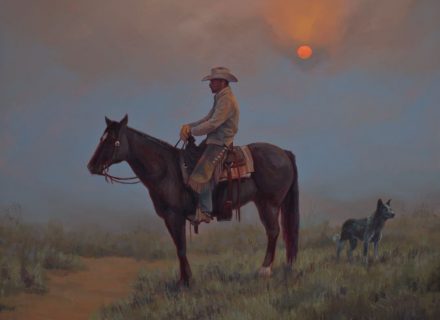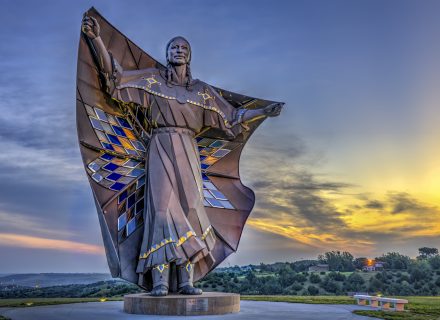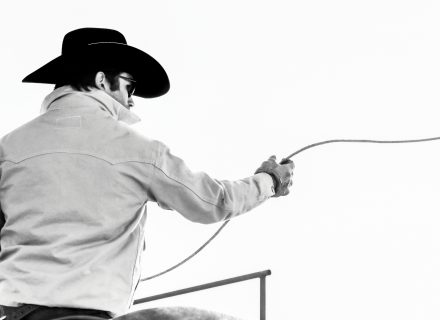The art of Montana master Tom Gilleon illuminates at Scottsdale’s Museum of the West.
His first paintbrush was a stick. As a young boy in Florida, Tom Gilleon spent endless hours drawing in the white sand that covered the lawn of his grandparents’ home. “Every day at 2 o’clock it rained,” he remembers. “You’d do your morning drawing, and at 2, you got a new canvas.” Eight decades later, Gilleon still exudes the sheer joy of creating, but he has long since traded Florida for Montana and the stick and sand for other mediums for his acclaimed art.
He took that leap of faith in the early ’80s while attending a workshop with other professional Disney artists at the Diamond Bar X dude ranch near Augusta, Montana. “It was January — 20 below, knee-deep snow. When I was there, I saw some land for sale and bought it. That was my introduction to Montana,” Gilleon says. His major design work at Walt Disney Imagineering included painting the design concept for Epcot World Showcase (Epcot Center); when he moved, Gilleon negotiated a deal that allowed him to continue working remotely for Disney from his new Montana ranch. “I remember as I was leaving Florida, Frank Zappa had a song out called ‘Montana’ with the lyrics ‘I might be moving to Montana soon.’”
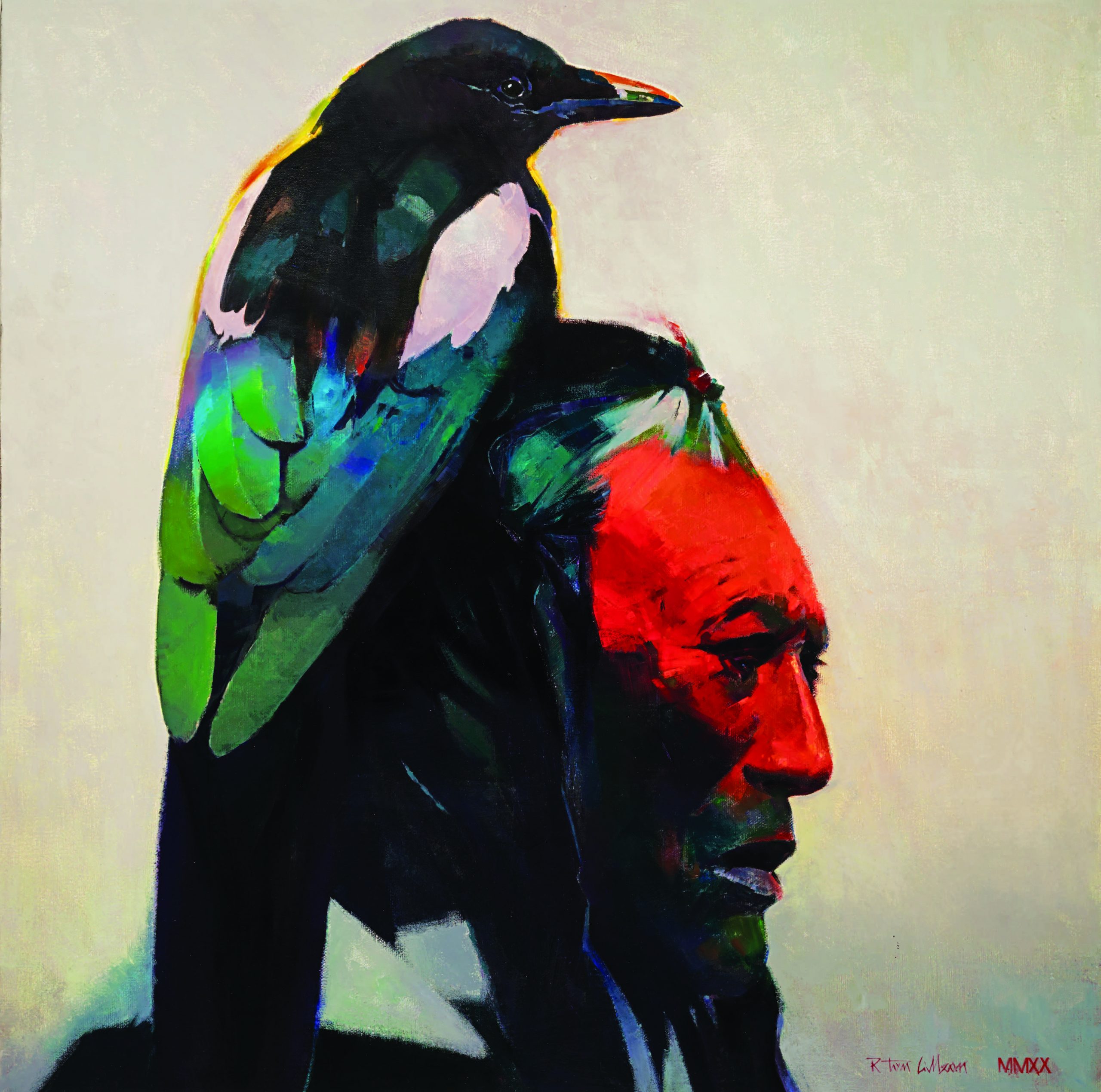 Magpie, 2020. Oil on canvas, 50” x 50”.
Magpie, 2020. Oil on canvas, 50” x 50”.
He also recalls people telling him he’d be back — but that never happened. Instead, Gilleon discovered new subject matter and new approaches to art. The first gallery owner to persuade him to pursue fine art was in Montana, and his new home state was full of inspiration. “I just really kind of fell in love with Native American culture,” Gilleon says. “It’s a prominent part of our world here in Montana.”
Gilleon’s Native American and Western subjects and mountain landscapes were an immediate hit. Now recognized as a living master, he paints in his studio at his Montana ranch, which includes the barn where Charlie Russell once kept his horse. Gilleon honors Russell’s influence in his work, but he’s not an imitator. At age 82, he remains eager to experiment with new methods of painting. His latest works don’t just push the envelope — they’re in a class by themselves. Spirit Catcher is a massive 12-foot-wide triptych digital painting set to original new music. In it, dozens of Native American images, based on the iconic photographs of Edward S. Curtis, morph one to another in a mesmerizing kaleidoscope of layers and colors over 22 visually ecstatic minutes. The groundbreaking work is among the many highlights of Inner Light: The Art of Tom Gilleon, a broad retrospective on view at Western Spirit: Scottsdale’s Museum of the West. Covering the breadth of Gilleon’s amazing career, the show includes more than 90 paintings from 26 collectors in 12 states who have loaned their work, including 12 paintings from his Disney years.
“Tom is an American modernist whose subject is Western,” says KingArts’ Richard King, Gilleon’s personal representative and co-curator, with Tim Peterson, of Inner Light. The exhibition presents 11 themes, ranging from nearby Fort Mountain and grain elevators and barns to Montana land and water and tepees. A favorite subject that Gilleon has returned to often since his earliest paintings in Montana, tepees have become one of his most popular subjects. “The campfire glow inside Tom’s tepees infers humanity,” King says. “Tom allows our imagination to fill in and co-author the painting. Like the glow of light in the lodge, we imagine the people inside —how they’re feeling and what they’re doing. He invites our imagination to finish the painting.”
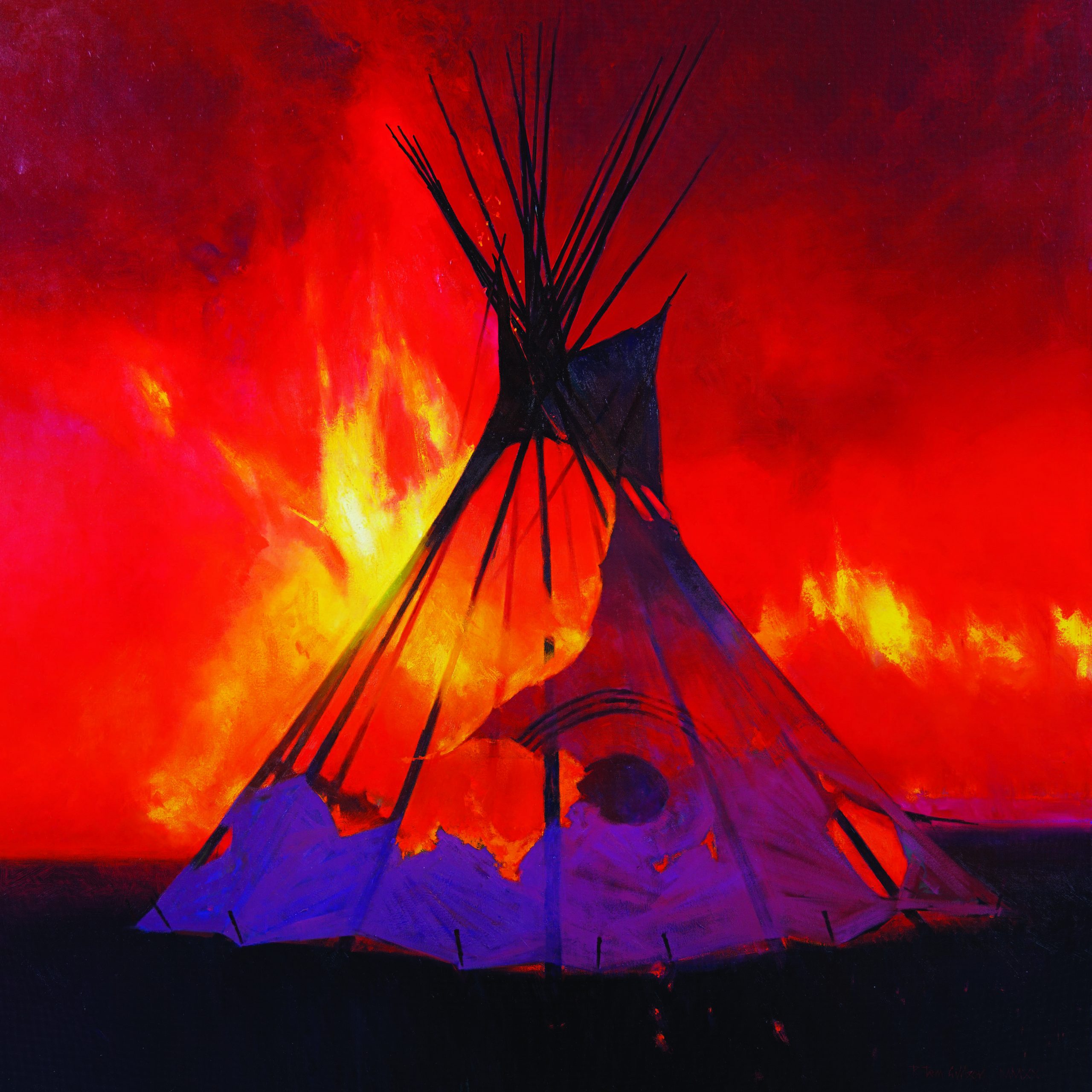 Brulé, 2021. Oil on canvas, 60” x 60”.
Brulé, 2021. Oil on canvas, 60” x 60”.
Nature is also prevalent in his work, and in a conversation from his studio at his ranch in Montana, Gilleon singles out a couple of works from the show to discuss. “Missouri River Winter is a very large canvas with ice ... ice floating in the river and snow on the banks. At the time, I had a studio on the banks of the river. Looking out the window of my studio, it was inspirational to be inside and warm and painting that outside scene. It was essentially a plein air painting, but I wasn’t in the plein air. Magpie, which is the painting on the catalog cover for the show, was done during a phase where I did a series of paintings of animals morphing into people and people morphing into animals.”
It’s a long way geographically and culturally from his home state of Florida, but some things have carried forward from his boyhood. Born in Gainesville, young Tom had been sent to live with his grandparents out in the country between Gainesville and Jacksonville after his sister contracted polio. His grandmother, who was Cherokee, taught Tom how to shoot a rifle as soon as he could hold one, instilling in the boy a lifelong belief in self-sufficiency. While he later returned to live with his parents, the influence of his grandparents never left him; in his art, perhaps no one was more influential than his grandfather, a Scottish immigrant cabinetmaker who often spent his evenings drawing. “Sharks, whales, and sailing ships,” Gilleon says. “He drew all kinds of things that were really interesting to me.” Young Tom began drawing, and he’s been drawing ever since.
The years that followed are worthy of a book, and there’s one in the works, along with a PBS documentary. Gilleon served in the Navy during the Cuban Missile Crisis as a ship cryptographer. He heard firsthand just how close the world came to nuclear war. “I don’t remember the fear,” he says. “It was just the resignation that we were all gone.” Earlier, the young seaman had marched in his dress blues in JFK’s inaugural, on a bitterly cold day in Washington. “Froze to death!” Gilleon says, recalling how he saluted as he marched by the new president. “There was only one suntanned face in that huge crowd — and that was Kennedy.”
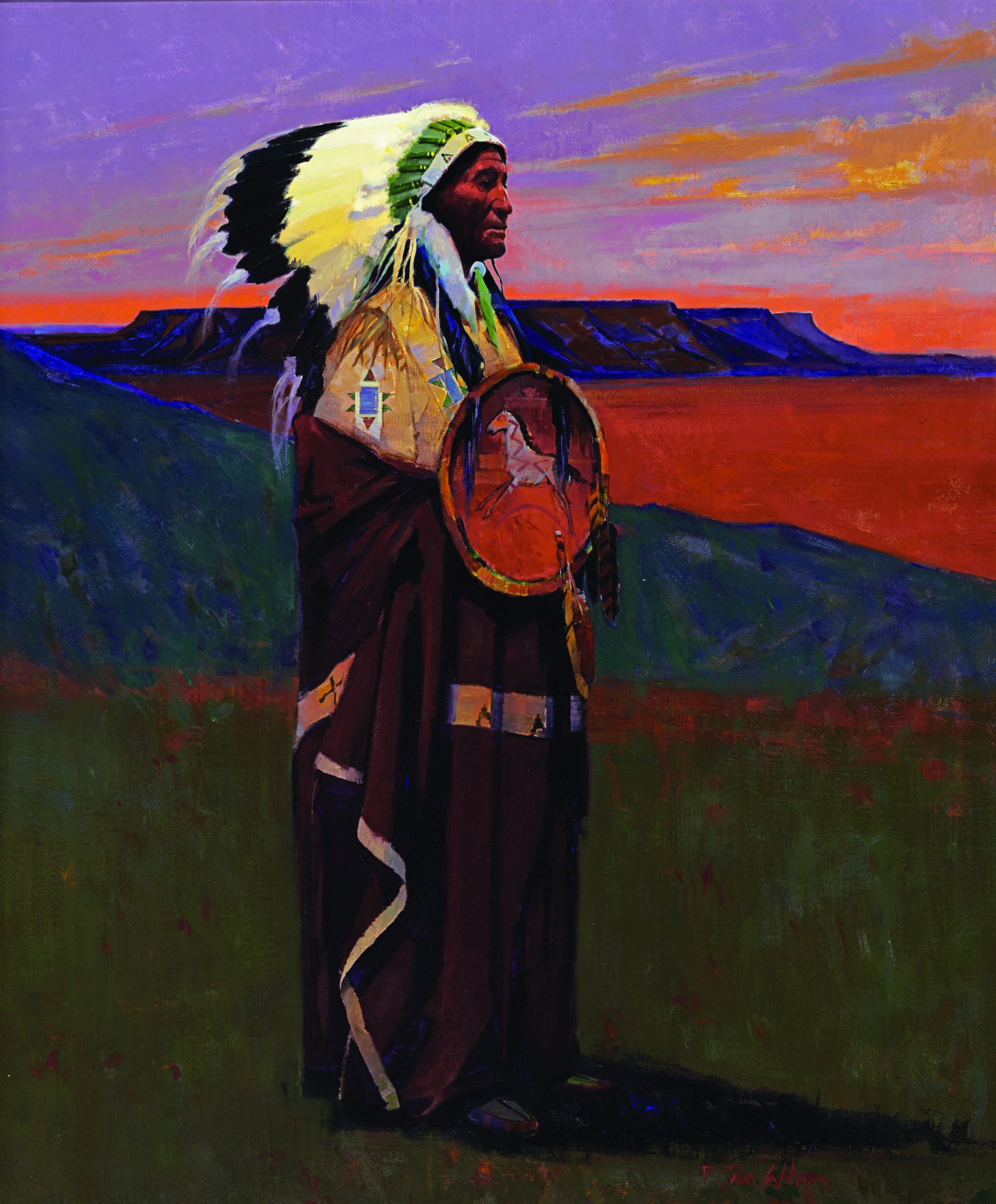 Standing Bear at Paha Sapa, 2017. Oil on canvas, 36” x 30”.
Standing Bear at Paha Sapa, 2017. Oil on canvas, 36” x 30”.
Once out of the service, Gilleon took classes to perfect the illustration skills he was using for freelance business clients. Discovered by the art department of defense contractor Pan American Airlines, he was soon drawing the rocket ships of the NASA space program.
By the early 1970s, Gilleon was once again a busy Florida freelancer — until he got a call from Disney. Soon transferred to the iconic Walt Disney Imagineering team in Glendale outside Los Angeles, the young artist was just in time to catch the tail end of the golden years of the Magic Kingdom, working with the legendary talents who’d collaborated with Walt Disney himself. “I had no idea at the time what a special time that was, with the collection of talent that was phenomenal,” he says. On staff for nine years, he helped design Disney theme parks in China, Japan, Hong Kong, and France, and then remained a Disney contractor after moving to Montana.
Those years with Disney still inform his work. In fact, the new digital paintings in the Scottsdale exhibition are made possible through a collaboration with Gilleon’s friend and former Disney colleague Marshall Monroe. A concept designer and technologist who invented the PIXoils™ platform used to create the digital paintings and other creative aspects of the work, Monroe focuses on the tech aspects “so Tom can stay in sandbox mode and have fun and paint. We want technology to bring this to life, but in many ways to be invisible — so the work can be a work of art that you can just walk up to and marvel at. It’s just super-fun,” Monroe says.
It’s fun for Gilleon, too. “I never really asked why I love it,” he says. “I just do! I just feel good when I’m doing it. ... It has to be something that really speaks to me. I paint it the way I want it.”
It’s a guiding impulse that harks back to those stick drawings in the sand. “If you do this long enough,” Gilleon says, “you get back to being as good as you were when you were 4 or 5 years old. I’m working in that direction.”
Inner Light: The Art of Tom Gilleon is on view through August 25 at Western Spirit: Scottsdale’s Museum of the West (scottsdalemuseumwest.org). Visit the artist online at tomgilleon.art.
From our May/June 2024 issue.
HEADER IMAGE: Dirge With Black Feet, 2022. Oil on canvas, 50” x 80”.
PHOTOGRAPHY: Courtesy of the artist














